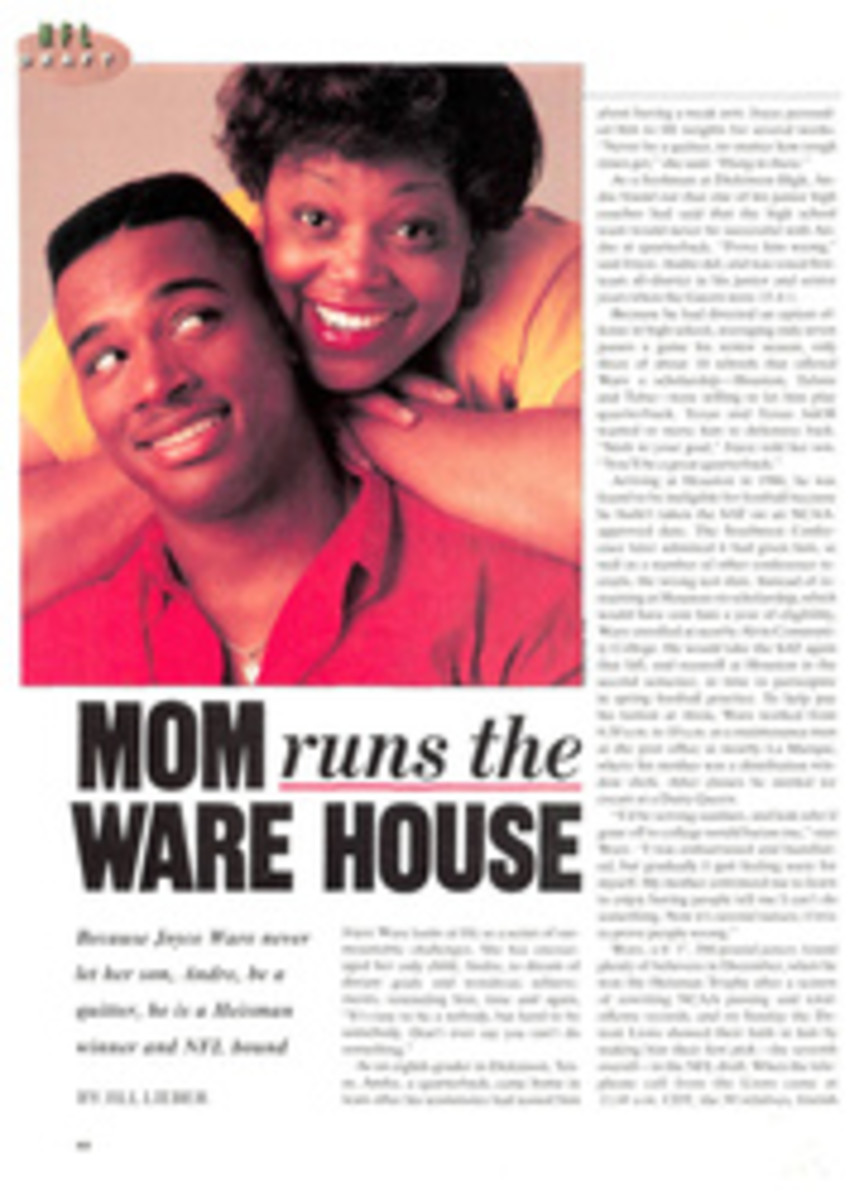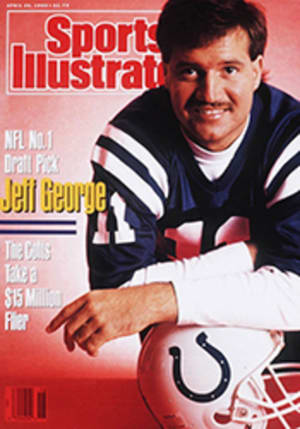
HARV HAS THE 76ERS' NUMBERS
Statistics superman Harvey Pollack started adding, subtracting and dividing for the Philadelphia Warriors in 1946, the National Basketball Association's inaugural season. Being young, the NBA had much to learn about statistics, and Pollack was just the man to set the pace in the art of counting, categorizing and crunching numbers.
Back when such NBA dinosaurs as Philly's Joe Fulks and Minneapolis's George Mikan roamed the courts, the official league stat sheets included only points scored, assists and individual fouls. That was when Pollack began keeping his own log of things like minutes played, rebounds, blocked shots, steals and turnovers. Without Pollack, former Warrior Wilt Chamberlain would never know how many career rebounds he ripped down. And fans could only guess at the name of the NBA player who grabbed more than 800 rebounds and dished out 800-plus assists in a single season (Oscar Robertson, in 1961-62, with 985 and 899, respectively). Sure, sooner or later someone else would have started counting rebounds and tracking minutes played, but Pollack did it virtually from Day One.
For 44 years Pollack, dubbed Superstat in 1965 by Philadelphia Bulletin sportswriter George Kiseda, has been courtside, his eyes riveted on the action, his pencil tallying who is doing what, and when. Today, Pollack and Boston Celtics president Red Auerbach are the only NBA originals still active in the league. "As far as I'm concerned, he's retired," says the 68-year-old Pollack of the 72-year-old Auerbach. "I'm the last of the Mohicans."
Over the years the league has incorporated many of Pollack's creations into its official statistical categories. But Pollack persists in dreaming up new ways to quantify hardwood action. He is so prolific along these lines that the 76ers' 260-page 1989-90 guide contains an eye-straining 208 pages of Pollack's beloved stats. His creative basketball accounting runs from the strategic (turnover/assist ratio by position, most possessions off the opening-tap) to the postmodern (most technical fouls, most prolific dunker, a team's total payroll costs per victory) to the downright weird (winning coin flips for the top draft pick, attendance figures for Sixers games during the 1967-68 repair of the Spectrum's roof). Pollack even keeps track of every NBA player's birthday and of little-known first names of coaches and players (so you know it's Arnold Auerbach; but how about Peter Tripucka). The Harv, as his friends call him, readily admits that coaches, players and fans have suggested some of his categories, and he credits each such contribution in the media guide. Across the NBA, writers, broadcasters and fans in the know keep a copy of Pollack's guide handy.
"Harvey Pollack is a one-time-in-history personality parading through the NBA," says former 76er general manager Pat Williams, currently G.M. for the Orlando Magic. "There won't be another person who's as absorbed, faithful or excited about what he does. To many people, stats are as dry as a bowl of shredded wheat without milk. But stats are sirloin steak to Harvey."
"Harvey's probably the most influential guy in the history of sports that nobody's ever heard of," says Mark Pray, public relations director for the Miami Heat, who remembers when The Harv moonlighted by keeping stats for the Baltimore Colts. "His innovations affect anyone who's involved with organized basketball."
Officially, Pollack is now Director of Statistical Information for the 76ers. He retired in 1987 as the team's public relations director, after a 25-year run. Talking with The Harv, you begin to understand how he came by his reputation for being a cantankerous character driven by a desire to keep his stats up-to-date. Not a day goes by, he says, that someone doesn't call him with a question on a statistical matter. "People are paying a lot more attention to basketball stats these days," says Terry Lyons, the NBA's director of media relations, "and Harvey's the reason."
In Philly, Pollack and his son, Ronnie, 43, a computer whiz who creates programs for his father, are a two-man stat gang. Besides their work with the 76ers, they keep stats for Penn, Temple, La Salle, Drexel and Villanova home basketball games, and for Temple football and the Philadelphia Wings of the pro lacrosse league. They once did the same for the Philadelphia Bell of the World Football League and the Philadelphia Fox of the women's pro basketball league. Pollack even coordinates the judging of the bands for Philadelphia's New Year's Day tradition, the Mummers' Parade.
Incredibly, Pollack has second and third careers too. He writes NBA Potpourri for the Sixers' newsletter and a column for Action, the Philadelphia Spectrum's monthly tabloid. Then there are his baseball and boxing columns, written under the pseudonyms Curley Diamond and K.O. Battle, respectively, for the Kensington (Pa.) weekly, The Guide. Oh, and there's After Dark, the entertainment column he also does for The Guide. Pollack critiques movies ("I go mostly to morning screenings"), plays ("isn't Kathleen Turner great in Cat on a Hot Tin Roof?") and Atlantic City casino shows and restaurants. A recent expedition to A.C. took Pollack and his wife, Bea, to the Sands to see dancers from Georgia ("the one in Russia," he notes), to the Claridge to do research for a restaurant review and to the Trump Plaza to catch Yakov Smirnoff and The Lettermen. How does The Harv keep up the pace?
"I'm organized," says Pollack. Then he looks sheepishly at the dog-eared stacks of paper and the overstuffed bookshelves in his Veterans Stadium office. "Well, I'm organized mentally, at least. I know where everything is." His office is an eclectic mix of the old (a Remington manual typewriter), the new (cartons of 1989-90 Sixers guides), the scruffy (an ashtray with one scrunched cigar butt) and the glamorous (a bulletin board covered with 8 x 10 glossies of Cher, Michelle Pfeiffer and Ann-Margret).
Pollack grew up a short walk from Shibe Park in North Philadelphia. As a youngster, he perfected the technique of sneaking into Athletics games by melting into various civic groups or groups from charitable organizations that were let in free. His favorite trivial childhood pursuit was verbally barraging pals with a baseball player's initials and challenging anyone within shouting distance to identify the owner.
As a journalism major at Temple University, Pollack was a five-sport (soccer, basketball, tennis, golf and gymnastics) team manager, a record that still stands. It was during the basketball season of his senior year that he began keeping stats. He spent nearly 2½ years overseas during World War II in Special Services, traveling all around Great Britain running trivia contests (what else?) to keep spirits high among the troops. At the time, his striking resemblance to comedian Henny Youngman seemed to be his major qualification for the job. Pollack returned to Philly in 1945 and became a sportswriter for the Evening Bulletin.
"At $28 a week, I needed to make other money," says Pollack. So he took a side job as statistician for games at Philly's Convention Hall. When the Warriors became Philly's NBA entry, Pollack was hired as the team's statistician and assistant director of public relations. The Harv's reign as the king of NBA stats had begun. "There hasn't been a year I haven't come up with something new," he says.
Pollack was there in 1962 on the night that Chamberlain scored 100 points against the New York Knicks in Hershey, Pa. He doubts that either that record or Wilt's 55 rebounds in a single game (1960) will ever fall. He also claims to have settled statistically the great center debate: Who was better, Chamberlain or the Celtics' Bill Russell. Based on Pollack's 142-game, head-to-head comparison, Chamberlain averaged 28.7 points and 28.7 rebounds, while Russell's figures add up to 14.5 and 23.7, respectively. "Russell's stats don't come close to Wilt's," Pollack says. "And when Wilt had those 55 rebounds, who do you think it was against? Bill Russell."
One stat Pollack has yet to scribble into his ancient blue plastic notebook—"My wife bought me a new one, but I won't use it. Maybe next season"—is how many NBA games he has seen. "I really don't know," he says. "But one day I'm going to sit down and figure it out."
Another statistical category is born: GVHs, games viewed by The Harv.
PHOTO
DAVID FIELDS
Pollack has kept an eye on Philadelphia's records since the first NBA season—1946-47.
PHOTO
DAVID FIELDS
Pollack's license plate has room to identify only one of his many careers.
Tom Starner, a free-lance writer from Philadelphia, dropped every statistics course he ever took.

